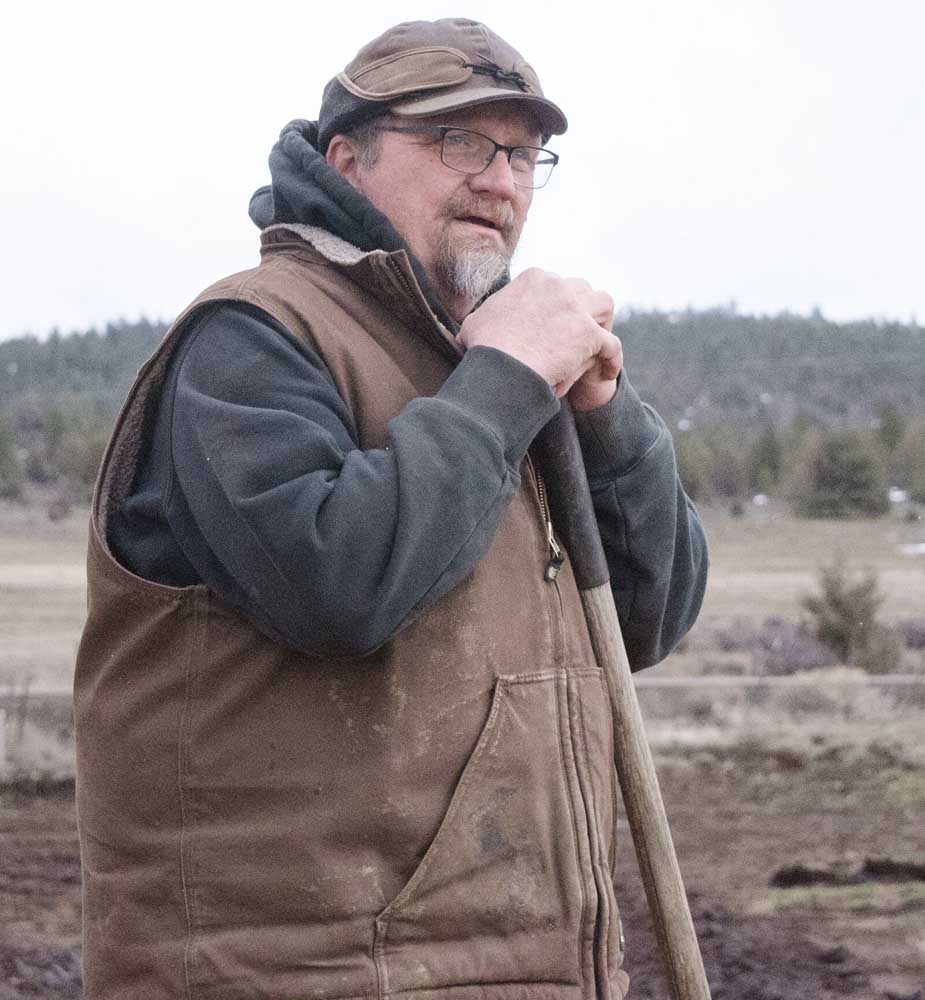Wolves at the door: A federal judge has redrawn the map for managing wolves in the West, and Grant County is at ground zero
Published 6:15 am Wednesday, March 23, 2022

- Roy Vardanega, a rancher in Fox, tends to his cows earlier this month. Last year Vardanega became the first rancher in Grant County to lose a cow to a confirmed wolf kill.
A judge’s decision to restore federal protections for gray wolves last month has put Grant County at ground zero for relisting the predators under the Endangered Species Act.
The decision drew a dividing line between wolf populations that can continue to be managed by state agencies and those that will once again be governed by more restrictive federal rules.
In most of Oregon, the dividing line is Highway 395, which runs right through the middle of Grant County.
While the ruling does not change anything for wolves in the easternmost part of the state, it does cover wolves in the western two-thirds of Oregon and puts them back on the federal endangered species list.
Before last month’s ruling, wolves in Western Oregon had been under the first phase of the state wolf plan, which allowed for killing wolves in defense of livestock and guard animals in limited circumstances.
Specifically, wolves could be killed if caught chasing or biting livestock or in situations where the state could confirm that a pack had depredated four times in six months.
Even then, before ranchers could use deadly force in a wolf attack, they had to have been using non-lethal deterrents such as electric fencing or hazing and had to show those methods had not worked to stop the attacks. Those options are now off the table, with federal protections back in place on Oregon’s west side.
Meanwhile, ranchers east of Highway 395, where wolves are under state management, can still shoot wolves caught biting, chasing or killing livestock or working dogs.
In many cases, ranchers are likely to have one herd of cattle on both sides of the highway. And with areas of known wolf activity in both the East and West Murderers Creek Wildlife Units on either side of the road, Grant County finds itself at the center of the long-running culture war flashpoint around wolves returning to the West.
Gray wolves were among the first animals protected after the passage of the Endangered Species Act in 1973, and the decision has remained a hot-button issue ever since. Predators have a long and controversial history in the West. The debate over protecting endangered species, especially wolves, has pitted urban liberals against rural ranchers concerned about losing their livestock to predators.
Roy Vardanega, a third-generation Oregon rancher, became Grant County’s first confirmed victim of wolf depredation last May, when five cattle on his Fox Valley ranch were attacked and killed — although only one of the deaths was determined by investigators to be a definite wolf kill.
He said the liberal elites who supported restoring the federal protections of wolves do not understand that the livelihood of independent ranchers like him is at stake — especially now that one of the few tools ranchers had to take out wolves that habitually prey on livestock has been taken away.
Vardanega said it is easy for city dwellers to romanticize wolves because they do not have to live with them.
M.T. Anderson, a rancher in Izee, lost a cow last month to a suspected wolf attack, although state investigators were not able to confirm wolves caused the animal’s death.
Anderson said he followed all of the protocols when wolves were delisted, adding that it was hardly “open season” on wolves before last month’s court ruling to put the predators back on the federal endangered list. All the state rules did, he said, was give him the legal right to protect his livestock and working dogs.
“And they just take that away,” Anderson said. “It’s the people that make these decisions, such as the judge who ruled to overturn the delisting. They’ve never had to deal with this kind of situation. It’s easy to sit in a courtroom and (make that decision). It’s not so easy when you’re the guy on the ground.”
Anderson said it’s hard to fathom that now, west of 395, where federal rules apply, it would be a felony for him to shoot a wolf that was killing his cattle.
Anderson said livestock owners now have no recourse when a wolf essentially steals their animals, something he finds antithetical to the country’s founding principles.
“That’s not how it works in America,” Anderson said. “That’s not how it is supposed to work.”
Even before last month’s court decision returned some wolf populations to federal control, many Oregon ranchers were already suspicious of the state’s wolf plan, part of a policy structure that they believe is rigged against them by a hyper-liberal majority in Salem.
Vardanega said he does not trust ODFW and believes the agency has made wolf depredation too hard to prove.
The reason, he said, is because the agency has to toe a left-leaning political line. Thus, the process of establishing wolf depredation is fundamentally skewed to favor an environmentalist agenda.
Not only that, he said ranchers suffer in ways that the current system doesn’t even touch. In addition to above-average losses in circumstances where they can’t prove wolf kills, non-lethal measures mean a lot of additional work for ranchers that involves extra vigilance and the cost of paying a range rider upwards of $1,500 a month.
Along with paying the range rider, Vardanega said he is often anxiously awake at 2 a.m., casting spotlights into the dark to defend his herds.
Why were wolves relisted?
Environmental groups sued the U.S. Fish and Wildlife Service and former Interior Secretary David Bernhardt in 2021, after the Trump administration removed wolves from the endangered species in the waning days of his term. The conservation groups argued the delisting was premature.
In last month’s ruling, Judge Jeffrey S. White of the United States District Court for the Northern District of California said U.S. Fish and Wildlife did not take into account wolves outside the Great Lakes and Northern Rocky Mountain regions when the agency proclaimed wolf conservation a success and removed the apex predators’ federal protections.
Ironically, removing wolves from the endangered species list is one goal that conservative and liberal administrations have long had in common.
Even though the decision to delist wolves came down during the Trump administration, attorneys for the Biden administration defended the rule that removed protections, arguing wolves were resilient enough to bounce back even if their numbers dropped sharply due to intensive hunting.
Not only that, but other Democratic and Republican administrations have tried to delist wolves over the years, failing every time. The last attempt to take wolves off the endangered list came during the Obama years.
According to John Williams, who chairs the wolf committee of the Oregon Cattlemen’s Association, the U.S. Fish and Wildlife Service has 60 days to decide whether to appeal the U.S. District Court ruling. So far, Williams said, the cattlemen’s association has not heard if the agency intends to contest the decision.
Williams said the judge denied the livestock industry’s request for intervenor status, which would have given groups like his the ability to appeal.
Meanwhile, the Center for Biological Diversity, one of the environmental groups behind the lawsuit that overturned the Trump administration’s delisting decision, is trying to extend federal wolf protections still further.
Collette Adkins, carnivore conservation director and senior attorney for the center, said the organization filed a petition with the U.S. Fish and Wildlife Service last year to restore protections for wolves throughout the Northern Rocky Mountains — including Eastern Oregon, thus putting wolves east of Highway 395 under federal jurisdiction as well.
Adkins said the agency would respond sometime this year.
The Blue Mountain Eagle attempted to interview representatives of the U.S. Fish and Wildlife Service for this story, but an agency spokesperson declined the newspaper’s request.
A question of trust
Ranchers who lose livestock to wolf depredation are supposed to be compensated for the value of the animals, but getting paid is not as simple as filing a claim.
First, the cattleman’s association’s Williams said, the livestock producer has to find the carcass — and they need to find it quickly, before decomposition makes it impossible to identify as a wolf kill. Then, he said, an investigation has to prove beyond a reasonable doubt that it was wolves that killed the animal.
If a wolf kill is confirmed, Williams said, the rancher can submit a request for compensation through their county’s compensation committee. That’s assuming the rancher’s county has a committee — not all counties do.
Finally, he said, there has to be money available in the county’s compensation fund. Those funds can be depleted by prior claims, and counties must apply to the state for more money on an annual basis.
The cattlemen’s association supported House Bill 4127, a measure in the 2022 Legislature to provide an additional $1 million for the state’s wolf compensation fund to reimburse ranchers for dead and missing livestock and the cost of non-lethal methods for preventing wolf attacks.
After a public hearing last month, the bill died in committee without ever getting the chance for a floor vote.
Oregon Wild, which joined the Center for Biological Diversity and four other environmental groups in the lawsuit that restored federal endangered status for wolves, opposed HB 4127.
Danielle Moser, coordinator of Oregon Wild’s wildlife program, said she wanted to see more transparency in the compensation program. Other critics argued that the wolf compensation fund is prone to misuse, and putting more money into it would encourage ranchers not to look for missing animals but instead simply default to blaming wolves.
Rep. Mark Owens, R-Crane, was one of the bill’s chief sponsors. He contends environmental groups targeted the bill not on its merits but simply because killing it would make their supporters feel good about protecting wolves.
“Bumper-sticker politics won the day without substance,” Owens said.
Who makes the call?
There were 49 confirmed wolf depredations across the state last year, according to Ryan Torland, a district biologist with the Oregon Department of Fish and Wildlife.
ODFW will continue to be the agency conducting depredation investigations, Torland said, even in parts of Oregon where wolves are now under federal jurisdiction. However, he added, only the U.S. Fish and Wildlife Service will be able to authorize lethal take of wolves in those areas.
“As far as I know … they have not approved the take of any wolves while the wolves have been on the endangered species list,” he said. “They possess that authority while listed, and ODFW does not.”
Torland said an ODFW investigation of a possible wolf depredation is similar to a detective’s evaluation of a crime scene. He told the Eagle that biologists gather information and send it to the agency’s wolf experts in La Grande, who make the call whether a wolf was responsible for the death of an animal.
He said ODFW investigators operate much like sheriff’s deputies, who would submit evidence from a crime scene to the district attorney to decide whether there is enough to prove someone committed a crime.
Grant County Sheriff Todd McKinley agreed with that assessment.
“It is not much different than a fairly major crime scene,” McKinley said. “You’ve got something that’s been killed or attacked, and you’ve got to find the facts. And if you’re going to do it, you better put the effort into it and do it right.”
McKinley had something like that in mind when he invited Baker County Sheriff Travis Ash to speak to the Grant County Stockgrowers Association about how Baker County handles wolf depredations during the group’s meeting at the Grant County Fairgrounds on Thursday, March 17.
Ash said he has heard the complaints, concerns and arguments from livestock producers regarding wolf depredations and how ODFW investigates them. However, he said, Baker County is about five or six years down the road from where Grant County is when it comes to wolf depredations.
The sheriff said his office runs parallel investigations of wolf killings along with ODFW and documents everything it finds so there is an independent record.
Ash encouraged the ranchers at the meeting to forge good relationships with the state wildlife biologists in their district. While he has butted heads with the top officials at ODFW, Ash said he is on good terms with the district biologists in his county.
“Build those relationships with those guys that have to do the work,” Ash said. “And understand, though, that if the evidence isn’t there, they have to say that the evidence is not there.”
McKinley’s staff is gearing up to do depredation investigations in Grant County. McKinley told the stockgrowers that Undersheriff Zach Mobley and Sgt. Danny Komning have been through ODFW’s wolf training and that he could get other deputies trained as well.
An emotional issue
For Vardanega, wolves are a personal issue.
Many of those who support putting wolves back on the endangered species list do not realize how hard ranchers work and how protecting their cattle against predators brings a high cost in both money and time.
“This is real life,” he said. “This is how we make a living.”
Vardanega said people who are adamant about protecting wolves would have a different view of the predators if they had to live next to them.
Vardanega’s wife, Sherri, put a finer point on the matter.
“They should let a wolf run loose at Central Park in New York,” she said. “They might feel differently about it.”
Oregon Wild’s Danielle Moser takes wolves personally, too.
To Moser, wolves are an iconic species that deserve protection.
“I think (wolves) are the essential American animal in many ways,” Moser said.
However, she said, the species has long been vilified with frightening stories like “Little Red Riding Hood.”
In the more recent meetings she has had with livestock producers and ranchers, Moser said, she’s noticed that their historical timeline picks up when wolves were not on the landscape.
Taking a longer view of history, she said, the species has been here since “time immemorial.”
Moser said the reason why wolves have not been on the landscape for much of the last century is because of human action.
For Williams, the wolf committee chair for the cattlemen’s association, the wolf debate boils down to two competing sets of values: one that prioritizes animals, and one that prioritizes people.
“(Environmentalists) have different priorities,” Williams said. “They’re more interested in hearing a wolf howl than they are (a rancher) being able to have their way of life.”
Gray wolves were once widespread in the United States but were trapped, hunted and poisoned until they were all but extirpated from the Lower 48 by the middle of the last century. The last native wolf in Oregon is believed to have been killed in the late 1940s.
In the mid-1990s, however, gray wolves were reintroduced in Central Idaho and Yellowstone National Park, and since then the species has expanded beyond expectations, both in population and geographical area.
There are now more than 1,600 wolves in the Northern Rockies, including at least 173 in Oregon, according to recent estimates.
However, wolves were never deliberately reintroduced to Oregon. They came here on their own, dispersing from established packs in neighboring states.
U.S. Fish and Wildlife captured the first known returning wolf in Oregon in 1999 near the Middle Fork of the John Day River and returned the radio-collared female, known as wolf B-45, to Idaho.
In 2011, Congress removed federal protections for the Northern Rocky Mountains wolf population, including Montana, Idaho and Eastern Oregon.
In 2015, the Oregon Department of Fish and Wildlife removed wolves from the state endangered species list, although the federal Endangered Species Act designation remained in the state’s western two-thirds.
In 2020, the Trump administration removed federal Endangered Species Act protections from gray wolves across 44 states, including Western Oregon.
A coalition of environmental groups filed suit in early 2021 to have federal protections restored, and on Feb. 10 of this year, a U.S. district judge granted their request.
— Steven Mitchell






